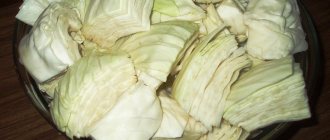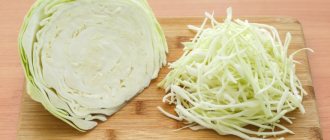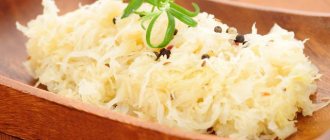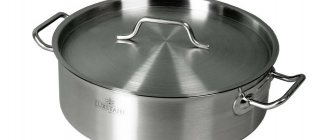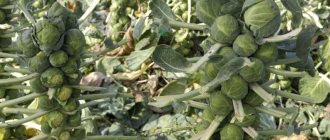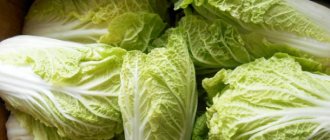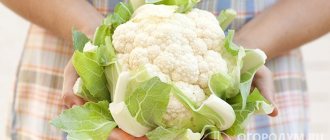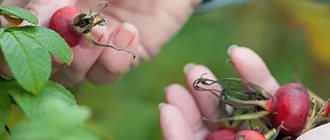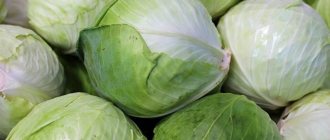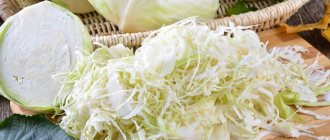Heads of mature hybrids can be stored for 8-12 months. The average shelf life of cabbage is 3-6 months, depending on the place of cultivation, variety and storage conditions. Taking into account the biological characteristics of cabbage varieties of different ripening periods, the storage duration can be: 1-3 months for early-ripening hybrids, 4-5 months for mid-ripening and mid-late ripening hybrids, and 6-8 months for late-ripening hybrids.
Optimal storage conditions for white cabbage:
Product temperature: −1 - +1.5 °C Relative humidity: 90 - 95%
Cabbage does not have deep and long-lasting dormancy and the ability to repair leaf damage. An important feature of cabbage is its relative resistance to short-term exposure to negative temperatures. Heads of mature varieties can withstand autumn frosts down to −5°C while still standing. Felled heads of cabbage are less resistant to frost; repeated frosts are especially destructive for them.
It is advisable to harvest cabbage intended for storage in the phase of physiological rather than biological maturity and in dry weather. Premature harvesting can lead to excessive wilting, and late harvesting causes cracking of cabbage heads; replanting frozen cabbage is not allowed. The stump of the head of cabbage should be cut slightly below the attachment point of the covering loose leaves, the cut should be clean, trimming the stump is necessary to protect the heads of cabbage from mechanical damage during transportation. The length of the outer stump of cabbage for direct sale should be 1 cm, and for storage - up to 3 cm.
Cabbage is placed in containers directly in the field and placed in a vegetable storage facility on the same day. It is recommended to store only late varieties of cabbage with dense heads and tightly fitting 2-3 leaves. Heads of cabbage intended for storage must be fresh, whole, unsprouted, healthy, not contaminated with soil and without excessive external moisture. When storing cabbage for long-term storage, you should carefully discard heads of cabbage that are severely damaged mechanically, as well as those affected by pests and diseases. Heads of cabbage should be selected that are leveled and of medium size. At the harvesting stage, it is important to prevent injury to the heads of cabbage.
.
Cabbage does not heal
, damaged leaves evaporate a lot of water, and loss of marketable qualities occurs.
During storage, cabbage heads generate a significant amount of heat and moisture.
, in similar conditions - approximately twice as much as potatoes.
Cabbage easily warms itself and is a leader in moisture release. The optimal storage temperature for edible cabbage is 0. +1°C. Short drops to -1.5 °C are not dangerous, but it is not recommended to allow them for a long time - this can lead to the formation of “cuffs”. Nebula - darkening and decomposition of the internal parts of the head of cabbage. In this case, the inner zone of the heads of cabbage dies off due to a lack of oxygen, the penetration of which is prevented by layers of ice formed between the leaves. In dense cabbage varieties, “cuffs” form much faster than in loose cabbage varieties.
Relative humidity during cabbage storage should be maintained within 90-95% and it is usually high due to intense moisture release. In the space between the heads of cabbage in a stack it approaches 97-98%, and in the atmosphere of the storage it fluctuates between 93-96%. Such high relative humidity helps preserve the mass of heads of cabbage
, since moisture loss due to evaporation under these conditions is small.
Immediately after laying the chambers, it is necessary to begin cooling the products and bringing them to storage temperature. With active ventilation, this is only possible using low night temperatures, so cabbage is harvested and planted when temperatures drop steadily to zero; freezing to −3 °C is not a problem. The main task of ventilation during the main period is to remove heat and prevent condensation. The intensity of ventilation in cabbage storage facilities is 2 times higher compared to potatoes.
Cabbage that is frozen but not frozen during harvesting can be stored under optimal conditions for 2-3 months. Such heads of cabbage must be stored in separate sections or compartments and the temperature in the cabbage layer must be immediately reduced to 0.−1 °C. Frozen cabbage is sold first.
Calculated values of heat and moisture release and bulk mass of products for cabbage
Heat release rate of vegetables (for cabbage)
Calculated parameters of internal air when designing the enclosing structures of a storage room for winter operating conditions (for cabbage)
Temperature, humidity and gas conditions. Maximum storage time for vegetables (for cabbage)
Calculated values of heat and moisture release from vegetables (for cabbage)
Do you want to save as much as possible?
harvest with minimal energy and resource consumption?
What sub-zero temperatures can cabbage withstand?
If the question refers to what sub-zero temperature cabbage seedlings can withstand, then we can say that hardened seedlings of cauliflower and white cabbage can withstand frosts down to -3 - -4 degrees Celsius. I would like to emphasize that these are hardened seedlings, but if you planted greenhouse seedlings and then frost struck, they will not survive such a temperature.
Features of cabbage growth
This crop requires high humidity and abundant watering: the soil on the site should not dry out. The most optimal temperature for its growth is from 15 to 20 °C.
The answer to the question whether cabbage is afraid of frost in the fall depends not only on the variety, but also on the preparation of the seedlings. Cabbage heads can retain their nutritional properties even with the onset of moderate frosts; for this, their seedlings must be hardened off shortly before the planting stage. This procedure ensures further resistance of plants to weather changes.
The crop may be subject to frost in early spring, when the likelihood of cold weather returning is high. Despite the fact that some hardened seedlings may still die as a result of this (they may burst), the rest will only become stronger. In regions with cold springs, later-planted varieties are more suitable for cultivation.
Additional Information! Greenhouses have the most suitable conditions for growing non-hardened seedlings. Such cabbage will be vulnerable to any bad weather and can deteriorate even with minor frosts and drought.
Hardening principles
Everyone who wants to get a good harvest is interested in this process, regardless of the natural conditions of the region. It is performed on fragile seedlings that have barely emerged from the ground.
Important! By the time of planting in an open area, the future head of cabbage should have 5 to 6 leaves and a developed root system.
The step-by-step process of culture hardening looks like this:
- Set the optimal temperature in the room for growing around 18-20 °C.
- After the first shoots appear, it is lowered to values from 15 to 17 °C during the daytime and from 8 to 10 °C at night. This measure will increase the plants’ resistance to temperature changes and protect the seedlings from stretching.
- 10 days before planting in the garden, open a window in the room with the seedlings and ventilate the cabbage for 3-4 hours daily.
- After the first 3 days, they begin to take them out into the fresh air for the same time, for example, onto a balcony or into the yard.
- After 6 days from the start of hardening, the plants are left outside and watering is limited to moderate.
Before planting in open ground, seedlings must meet standards
These actions will affect how many degrees of frost the cabbage will withstand, and will also provide the seedlings with resistance to drought and prolonged cloudy weather. At the end of the growing season corresponding to the variety, subject to standard growing conditions, rows of hardened cabbage will produce an abundant and high-quality harvest.
Note! Hardening off, which prepares sprouts for planting in regions with high cloudiness, uses shading. Starting from the 3rd day of hardening, when the seedlings are taken out into the air, a tent made of gauze or a material with similar air permeability properties is placed over them.
How much frost can cabbage withstand? Cabbage and frost
In various regions, the period of possible cooling may last until mid-June.
Whether cabbage seedlings are afraid of frost, what kind of frost cabbage can withstand in the spring, and how low temperatures can affect the quality of the crop depends on what type and variety was chosen for cultivation.
Plant seedlings with the seedless growing method die at -3°C. If the seedlings were grown in cold greenhouses or were pre-hardened before planting in the garden, then they can withstand a short-term decrease in temperature to -5°C, but in this case the total weight and quality of the finished heads of cabbage decreases.
If the temperature outside drops below -5°C, the seedlings die.
Reasons for freezing cabbage
Let's consider the reasons for the death of cabbage during frosts. Both frost and heat are harmful to the development and life of cabbage seedlings in spring.
If the air temperature drops below 0°C, the water in the plant cells freezes and turns into ice. From the physics course we know that if water is frozen, then when it freezes it increases in volume. The same thing happens in plants. When frozen, the liquid ruptures the seedling cells from the inside, and the cabbage dies. Sudden thawing after sunrise is especially dangerous for plants.
The influence of low temperature can aggravate the wrong choice of planting site, as well as the condition of the seedlings.
Risk areas for cabbage
Do not plant plants on heavy soils or in lowlands. Light loamy areas well protected from the wind are suitable for it. In addition to the fact that there is constant stagnation of moisture in the lowlands, the air during frosts is also 2-3°C lower than in the flat areas.
For optimal plant development, the soil should not be acidic. On such soils, cabbage will not be able to develop normally, it will get sick, and the fertilizers that you apply will not be able to be completely absorbed by the seedlings.
Therefore, if the soil on the site is acidic, then it needs to be limed. Dolomite flour is perfect for these purposes, as it will additionally enrich the earth with potassium. If flour is not available, you can use chalk, ash or lime. Only lime can be used exclusively during autumn digging, so as not to damage the seedlings.
This is interesting: We remove cabbage from the garden for storage for the winter
Whether cabbage is afraid of spring frosts, and how affected the seedlings will be, also depends on the general condition of the plants. If they are healthy, have managed to strengthen and grow well, then the seedlings will recover from stress much faster and the damage to the crop will be minimal.
To grow healthy seedlings, you need to maintain temperature conditions. The optimal range is 12-20°C. Higher temperatures lead to seedlings beginning to lag behind in development, becoming weak and not as viable.
It is also necessary to monitor the water regime. Cabbage is a moisture-loving plant, but watering should be such that there is no stagnation of water in the holes. Excess water, as well as its lack, can lead to disease or death of plants.
On a note! The tolerance of low temperatures by seedlings also depends on the type of cabbage.
Harvest dates
Usually this vegetable crop is the last to be removed from the beds, as it is exceptionally cold-resistant and grows even at low temperatures. First of all, the harvest date is influenced by the ripening time (variety) of the vegetable and the climatic conditions where the crop is cultivated.
Climatic conditions (by region)
The climate of the region where cabbage is grown plays a decisive role. For example, in the Moscow region and central Russia they begin to remove it from the second half of September and end in mid-October. It is necessary to place the vegetable in refrigerated storage, otherwise the heads of cabbage may rot. In the Leningrad region, the harvest ends at the end of October, but they always pay attention to the weather. It is not recommended to start collecting in rainy weather. In Siberia and the Urals, white cabbage ripens by the end of September or beginning of October.
Attention! If the mark on the thermometer reaches 0°C at night, and does not exceed 8-10°C during the day, then it is time to harvest the vegetable.
Weather conditions play a key role in vegetable cultivation. The culture loves wet and cool weather. Therefore, if the summer was like this, heads of cabbage will form on the bushes in the shortest possible time, and the vegetable will quickly ripen. If there is no rain and intense heat in the summer, crop growth will slow down and the harvest will ripen later than usual.
Variety ripening period
Cabbage can be early-ripening, mid-ripening and late-ripening. Depending on its variety, the harvest can be harvested at the end of June, July, August, September and even October. Different varieties ripen on different calendar dates (see table).
| Variety type | Collection start time | Collection end time |
| Early ripening | End of June | Mid July |
| Mid-season | Mid August | Beginning of September |
| Late ripening | Mid September | At the first frost |
You should not delay harvesting early ripening varieties, as the heads begin to crack and become soft. This culture is not suitable for long-term storage. Early products are often grown for sale and for making fresh salads. To prepare vegetables for the winter, choose late or mid-season varieties that can be harvested after the first frost.
External signs of maturity
The maturity of the heads of cabbage is another equally important factor that should be taken into account. Only ripe heads of vegetables need to be stored for long-term storage. Cabbage is ready for harvesting if:
- the head of cabbage has stopped growing (its size does not change for several weeks);
- head weight 600 g (for early and medium varieties), over 600 g (for late varieties);
- the heads of cabbage are hard, dense, elastic to the touch;
- a light glossy spot appeared on the “top” of the head of cabbage;
- the lower row of leaves is yellowed;
- the integumentary leaves adjacent directly to the head of cabbage are wrapped slightly upward in a boat.
When everything indicates that the vegetable has completed ripening, you need to stop watering at least 10-14 days before the expected harvest. Then, depending on the weather, they begin harvesting.
When to cut broccoli in open ground You should know that harvesting is as complex a process as growing vegetables and fruits itself. Having planted...
Effect on frost resistance
Formed heads of cabbage can withstand up to -10 degrees for 1-1.5 weeks. With the seedling method, seeds are planted directly in open ground. In case of unexpected frosts, the seeds may die, since they are not sufficiently formed and strong enough for stressful situations.
With the seedling method, young plants have time to form a root system and strong stems. In addition, you can weed out potentially weak plants and leave only strong and hardy specimens for planting in open ground.
Hardening off seedlings increases the frost resistance of cabbage. This method prepares seedlings for constant conditions in the garden, increases their immunity to stressful situations and temperature changes.
There are early ripening and frost-resistant varieties that are genetically more resistant to temperature changes than ordinary ones. Therefore, before planting a crop, it is better to familiarize yourself with the selected variety in detail. Suitable growing conditions can be read on the seed packet.
Rule 1. Properly plant seedlings in open ground
“Large seedlings are already overgrown, they will not produce a large harvest and are more susceptible to disease”
| Boarding time |
Planting times will vary for different areas.
Approximate disembarkation times:
- southern regions - end of March;
- middle latitudes - early May (late cabbage and red cabbage, Brussels cabbage - at the end of May);
- Ural, Siberia, Transbaikalia - late May, early June.
You need to focus on warming up the air during the day.
The average daily temperature should stabilize to + 10 °C
Comfortable temperature for cabbage
Temperature that is comfortable for cabbage of any variety and ripening period:
- seeds germinate at a temperature of +20...+22°C for 3-5 days;
- those sown at +16...+18°C will sprout within 5-10 days, but such sprouts are not resistant to blackleg and fusarium;
- when the first growth points appear, the seedlings are transferred to a bright room with a temperature of +8…+12°C;
- when 1-2 true leaves appear, the temperature is increased to +16...+18°C;
- the formation of the first leaves occurs even at +7...+10°C, however, such heads of cabbage set poorly and go into flowering in the first year of development;
- 5-7 days after picking the seedlings, the time for hardening comes - the seedlings are taken out onto the street or balcony and kept for 1-3 hours daily at a temperature not lower than +6...+8°C;
- cabbage seedlings planted in open ground develop correctly at +12…+22°C;
- mature, formed heads of cabbage gain juiciness at a stable +15…+20°C;
- early ripening varieties and hybrids ripen at +16…+22°C.
On the first day after seed germination, at an air temperature of more than +15°C, the sprouts become very elongated and become unusable.
Description of culture
Belongs to biennial plants of the cruciferous family. It has a tall, leafy stem.
In the first year, a basal leaf rosette grows, which is widely used in cooking, cosmetology, and folk medicine, and in the second year the seeds are obtained.
The leaves are glabrous and usually have a grayish-green or bluish-green color. In the lower tier they are quite large, fleshy, with strongly pronounced veins. Due to the fact that they fit tightly to each other, a head of cabbage is formed around the stem. The part of the stem located in the head of cabbage is called the stalk.
Cabbage flowers are large, in a multi-flowered raceme and yellow in color. The seeds are located in pods that reach a length of 10 cm. The seed is dark brown in color and has a spherical shape, up to 2 mm in diameter.
- Early in the morning, you need to spray the damaged leaves with cold (not warm) water and shade them so that the plants thaw more slowly. This thawing will slightly soften the effects of frost.
- The use of special antidepressants - chemicals that are sprayed on damaged plants - has proven itself to be effective.
At what temperature does cabbage stop growing?
The growth of heads of cabbage in open ground is influenced by both a decrease and an increase in ambient temperature:
- at +5…+8°C growth slows down, it is recommended to reduce watering;
- at +2…+5°C metabolic processes slow down and development stops;
- at 0…+2°C the leaves may turn yellow and growth stops.
This is interesting: When to harvest cauliflower
Cabbage does not tolerate prolonged exposure to ambient temperatures exceeding +25°C. When hot weather sets in, the heads of cabbage stop developing and may die. To preserve the harvest, it is recommended to pay special attention to watering and shade the plantings at this time.
If the cabbage is caught in the frost. Different opinions on pickling frozen cabbage
Different housewives' opinions on whether it is possible to ferment frozen cabbage may differ radically. Some say that frozen vegetables can no longer be used for pickling. They believe that such cabbage, if fermented, will turn out too soft and will not have a crunch. Others have a different opinion on this matter.
Much of the suitability of such cabbage for further pickling depends on the condition of the head of cabbage after defrosting. An important point is how long the vegetable was frozen.
And sometimes it happens that only the top leaves of the head of cabbage are frozen. In this case, you just need to remove them and use the rest of the cabbage for processing.
Sometimes it happens that housewives do not have time to salt the heads of cabbage that are stacked on the veranda or balcony and are intended for further processing. If this cabbage freezes with the onset of cold weather, you should not immediately bring it into a warm room.
It is better to defrost the heads of cabbage gradually in a cool place. When they thaw, it is possible that the cabbage will remain the same in texture or just a little softer than fresh.
It happens that only the top leaves of the head of cabbage are frozen. It is enough to remove them and use the rest for fermentation. But the head of cabbage can be completely frozen. It is necessary to remove damaged and rotten leaves, cut or drill out the stalk, after which this cabbage can be fermented.
If the cabbage leaves are too flabby after defrosting, it is better to use them for current cooking rather than for pickling.
You can ferment cabbage that has been frozen in the same way as regular fresh cabbage:
- whole heads of cabbage;
- halves or quarters of heads of cabbage;
- shredded with or without various additives.
Frozen cabbage often ferments even faster than fresh cabbage. For 10 kg of vegetables take 200-250 g of salt. If the frozen cabbage juice released during the ripening process is not enough, you can add a little salted water.
Frozen cabbage may still be suitable for fermentation. Of course, this is possible if it has not become too flabby and the rotting processes have not affected the entire head of cabbage. As an independent dish, such sauerkraut will not be so good, but it will be suitable for preparing first and second courses.
Experts' opinions on whether frozen cabbage is suitable for pickling vary. Some people believe that frozen vegetables are not suitable for pickling. Others claim that such cabbage will be soft but tasty if the vegetable is properly salted. Of course, the cabbage will no longer be crispy. But such a product will perfectly complement any dish, for example, borscht, cabbage soup or vinaigrette.
In this case, the taste of the treat will depend on how long the vegetable was frozen. If the heads of cabbage froze during a sharp frost, perhaps only the top leaves were damaged, but the inside of the vegetable remained suitable for cooking.
Attention! Cabbage leaves that have been frozen once are suitable for pickling. If a vegetable has previously been defrosted, it should not be used for pickling.
The product loses its usefulness, dense sheet structure, taste, and putrefactive processes may develop inside.
If you still have doubts about whether it is possible to ferment cabbage if it is frozen, you should familiarize yourself with the recipe for pickling such a product.
You can salt frozen cabbage for the winter in several ways:
- whole heads of cabbage;
- halves and quarters of vegetables;
- shredded sheets with the addition of spices and herbs.
This is interesting: Why holes appear on cabbage leaves and what to do about it
At the same time, fermenting frozen cabbage is even faster than fresh cabbage. Thanks to softer sheets, the product preparation time is reduced several times. For 10 kilograms of vegetables you will need approximately 200-250 grams of rock salt. If little juice is released during ripening, you can add salted boiled water to the preparation.
Completely frozen heads of cabbage can also be suitable for pickling, unless they have begun to rot and become too soft. It is not recommended to ferment such a vegetable for the winter, but it is suitable for preparing first courses, vegetable stews, meat with vegetables, or stewed potatoes with sauerkraut.
The best frost-resistant cabbage varieties
Cabbage is in demand all over the planet, but it is quite difficult to grow in regions with strong temperature changes, as well as early-onset long and frosty winters.
For this reason, in areas with weather conditions unfavorable for cabbage, varieties suitable for growing in these areas are developed. However, there are several common types of crops known for their resistance to cold.
Aggressor
This cabbage variety, bred by Dutch breeders, grows in the middle zone, in the south, east and north of the Russian Federation, producing massive covering dark green leaves. Late-ripening Aggressor can grow in strong winds, excess humidity, poor soil composition and cold snaps down to -7 °C.
Its heads of cabbage require a lot of space, gaining up to 5 kg. In addition, the variety is characterized by powerful roots, ease of care, resistance to diseases and cracks, good keeping quality and fertility.
Mara
The Mara variety, which arrived from Belarus, is a medium-sized cabbage weighing more than 3 kg. Its best characteristics are long-term storage, resistance to excess moisture, good yield and strength of heads of cabbage. This cabbage, harvested shortly before the onset of winter, is distinguished by its pleasant taste and blue-green color of fruits that are not subject to rotting and cracking.
The variety is quickly spreading throughout the Russian Federation. Despite the fact that it is recommended for cultivation in the central zone of our country, the autumn cold does not prevent it from developing.
Moscow
This variety is adapted to grow in Central and Northwestern Russia, as well as in the Far Eastern regions of the Russian Federation. Late-ripening Moscow cabbage comes in 2 types: late-15 and late-9.
The first is very easy to care for due to its high rosette, the second, on the contrary, has a squat trunk, but is more resistant to the keel. The flattened heads of the crop gain up to 4.5 kg and can withstand frosts down to -10 °C.
